by Winding Pathways | Apr 6, 2023 | Birds, Nature
Yellow-bellied sapsuckers are precise timers. Every late March we look for this gorgeous, yet sometimes hard-to-spot, migrating bird. They visit our woods in April on their way to northern breeding areas.
Weather Conditions
Late March and April nights are often below freezing, followed by warm days. That temperature fluctuation stimulates maples to send sap upward. At the same time, the warmer days awaken hungry insects seeking sweet meals. Yellow-bellied Sapsuckers arrive from the south at sap time and make their familiar wells, or small rows of holes, through maple bark. Sap oozes out and attracts protein-rich insects. Hungry migrating sapsuckers dine on both sweet sap and tasty insects.
Yellow-bellied Sapsuckers are Precise Timers
Yellow-bellied Sapsuckers time their migration precisely. They arrive exactly when conditions are perfect. Within a few weeks the weather warms, maples stop bleeding sap, insects disperse, and the birds are north of us getting ready to nest.
-
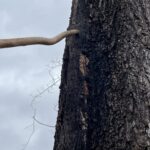
-
Insects are attracted to the sap weeping from maple trees.
-
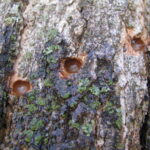
-
sapsuckers time their arrival well.
by Winding Pathways | Mar 16, 2023 | (Sub)Urban Homesteading, Birds, Nature
Tree Sparrows. Two species. What could be more confusing? Well, there’s more. Both look like common House Sparrows (formerly known as English Sparrows.
Meet the American Tree Sparrows
Marion glanced at our feeders recently and noticed what looked like a Chipping Sparrow in the midst of a flock of House Sparrows. But it wasn’t. It was an AMERICAN TREE SPARROW. This bird nests in far northern Canada and is almost always spotted in winter. Why it doesn’t keep flying south and winter somewhere warmer than Iowa is a mystery to us. The bird does look like a Chipping Sparrow, but it’s bigger and “chippers” left long ago to winter where it’s warmer. We won’t see one again for a few months. So, a rusty capped sparrow in winter stands a good chance of being an AMERICAN TREE SPARROW.
Meet the New Tree Sparrows
Rich looked out the window a few days later and spotted an odd bird. It was near House Sparrows but looked slightly different. A dark spot on its cheek revealed it as a EURASIAN TREE SPARROW. What was it doing in our Iowa yard?
Back in 1870 a box of wild birds arrived in St. Louis from Germany. Inside were 12 Eurasian Tree Sparrows that were released. They slowly spread outward.
According to the Cornell University Laboratory of Ornithology’s ebird the bird spread north slowly and took about 150 years to reach our yard. It’s been widely spotted across the United States, but mostly along the Mississippi River.
Differences in Habitat Preferences
It looks like a House Sparrow at a quick glance. House Sparrows are at home in urban areas while the European Tree Swallow is more a denizen of brushy areas outside town. Sometimes they mingle. See a flock of House Sparrows. Take a close look. One may be a European Tree Sparrow.
European and American species share one trait. Both prefer feeding on the ground. Why they’re called tree sparrows beats us.
Learn More!
For accurate information on birds check out the Lab of Ornithology’s website.
-
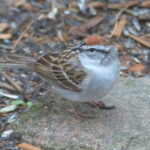
-
Chipping Sparrow
-
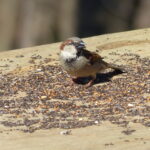
-
House Sparrow
-
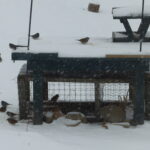
-
Can you find the sparrows?
by Winding Pathways | Dec 15, 2022 | Birds, Garden/Yard, Nature

A chickadee gently cradled in man’s hand.
On an early, warm, bright November day, several Coe and Mt. Mercy University Students with their professors arrived at Winding Pathways to band birds. They stood mesmerized as one cradled a diminutive bird in his hand. This long-distance traveler had met a temporary misfortune.
It was a golden-crowned kinglet, a tiny bird tipping the scales at only .19 ounce. On a recent night, it had winged south from its summer home in the north and decided to rest and feed amid the tall grass and woods at Winding Pathways. Then, it would continue southward. It didn’t know that Dr. Neil Bernstein had other plans.
-
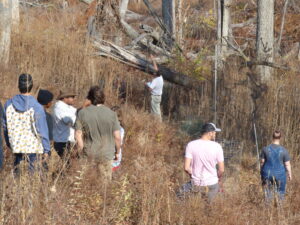
-
Dr. Bernstein sets a mist net by a fallen log.
-
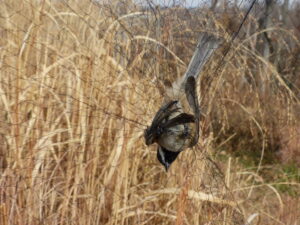
-
trapped chickadee
-
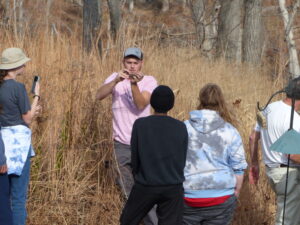
-
Untangling bird
Neil had stretched mist nets an hour earlier. The kinglet, along with chickadees and a Carolina wren didn’t see these fine mesh nets in time. They were caught but uninjured. Neil showed the students how to band birds by gently removing them from the net, weighing each tiny bird, recording data, placing a small lightweight band around its leg, and releasing it. Data are then submitted to help researchers better understand bird migration.
The kinglet and wren waited patiently as students weighed and banded each, but not the chickadees. These bitty, year-round residents have an attitude. They didn’t like being held one bit and pecked at the student’s fingers.
-
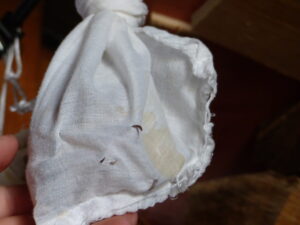
-
A bird’s claws poke through the bag.
-
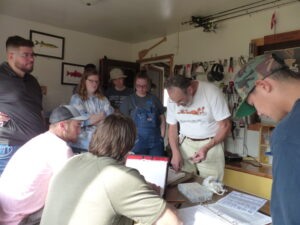
-
Verifying information is important.
-
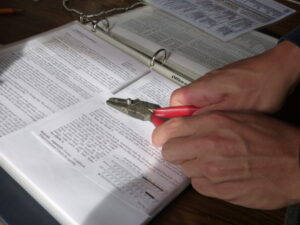
-
Tiny band ready to attach to a bird
-
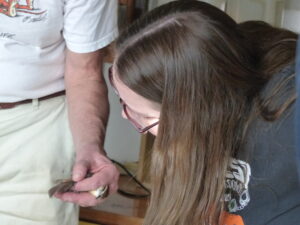
-
Checking feathers
Student Reactions
Students were used to collecting scientific data on different natural topics. They were fascinated by the process of banding birds. “I thought we were going to listen to a bird band!” joked one student. Another envisioned running around chasing birds, concluding that would not work well.
Students commented on how the pecks were sharp but not worrisome. One explained she talked quietly to the chickadee as she carefully held it. Reassuring the bird, she would not hurt it. “I could feel its heart rate slow down,” she commented.
Although chickadees are small, kinglets are even smaller. This kinglet will carry its band as it wings southward but chickadees are homebodies and will wear their bands as they flit around our yard all winter.
Why Band Birds?
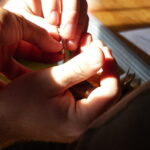
Tiny band with a number.
Banding is a traditional way of learning where birds go, habitat needs, and the impact of climate on both. Perhaps a fellow bander will catch “our” kinglet and inform scientists at the US Geological Survey.
by Winding Pathways | Nov 24, 2022 | (Sub)Urban Homesteading, Birds, Bugs, Flowers/Grasses, Foraging, Garden/Yard, Nature
We think of fall as migration time when all the birds leave. And there is a great birdcast website to see in live time the flights. But an autumn walk through a park with wild edges reveals shrubs, bushes, and grasses alive with bird activity. Visit an orchard on a cold winter day and the odds are good for spotting robins pecking on frozen dropped apples, but wild fruits are more common, all just beyond suburbia.
Let’s step back to spring. When Rich worked at the Indian Creek Nature Center his phone would often ring during those first warm days. With excitement callers would announce that the robins had returned. Spring’s here!
Seeing a robin on a spring lawn gives the illusion that they’ve just made a long journey from a faraway wintering ground down south. Robins, bluebirds, and other birds usually just shift where they live and forage as seasons change.
Ecological Survivors
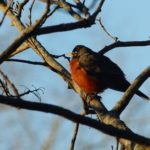
A robin surveys the area
Robins, in particular, are ecological survivors. They’re adapted to living on lawns and around people during the warm months, where they nest on porch eaves and forage for worms and bugs in mowed grass. The coming of fall’s cold marks the disappearance of robins from suburbia. They don’t go far and make an amazing dietary switcheroo to wild fruits.
Robins and bluebirds shun their summer buggy and wormy diet and shift to fruits and some seeds come winter.
On an October walk, we spotted several wild fruits – berries perhaps – that birds feast on during the cold months. the native plants are great – even the poison ivy – the exotics are problematic.
Here are some common winter weedy and seedy plants:
- Gray Dogwood. This small native dogwood often forms thickets along trails, parks, woods, and even yards and holds plenty of berries into cold months.
- Wild grapes. People rarely eat sour and seedy wild grapes, and sometimes birds also leave them alone during summer, but come winter the raison-like grapes make nutritious avian fare.
- Poke Weed. In late fall this tall purple-stemmed and fruited plant is hard to miss. Birds eat the frozen berries. Note: Poke berries are toxic to people and many mammals but not birds.
- Poison ivy. Gulp. This bane of allergic people is a beneficial wildlife plant. Deer and rabbits browse on the woody sprouts and birds feast on the berries.
- Asian Honeysuckle, Japanese Barberry, and Oriental bittersweet are “dirty bird plants.” Actually, birds love the berries and carry them far and wide to poop out the seeds. All three exotic plants are highly invasive and crowd out more desirable native plants. Birds have helped them conquer woodlands and field edges to the detriment of healthy bio-diversity.
-
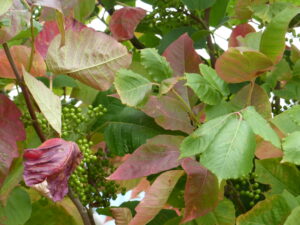
-
Poison Ivy berries are a favorite of birds.
-
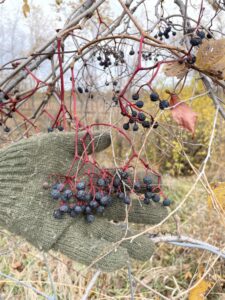
-
Wild grapes are a tasty winter treat.
-
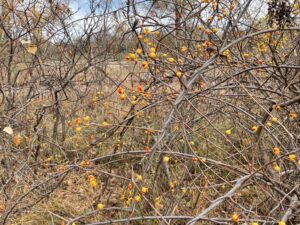
-
An invasive species and favorite of birds.
Winter Fare Is More Than Fruits
Winter bird fare isn’t just fruit. Many birds glean frozen spiders and insects from crevices in tree bark and dozens of species continue to eat grass and “weed” seeds. That’s a problem with mowed lawns. They produce no seeds, so few birds visit them during the colder months. Taller growing grasses, flowers, and shrubs often hold their seeds into the winter and are bird magnets.
-
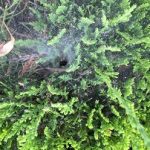
-
This beneficial spider controls insects in the yard.
-
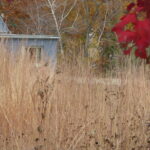
-
Birds bob on prairie grasses.
-
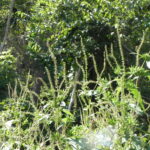
-
Ragweed seeds last through the winter.
Want to have birds in the yard all winter? Keeping feeders stocked helps, but better results come when homeowners encourage buffers of native shrubs, vines, and grasses that produce natural winter bird food and habitat. Most people love their tidy lawn, but edging the lawn, usually along a property line, or creating “pocket prairies” with native or desirable tall grasses, wildflowers, and shrubs adds summer color and year-round wildlife appeal. So, we encourage readers to create and leave wilder spaces for the birds!
by Marion Patterson | Nov 10, 2022 | Birds, Nature
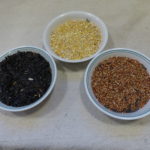
Sunflower seed, cracked corn, milo.
Feeding backyard birds is fun, but it’s become expensive. The price of black oil sunflower seed has doubled in just a couple of years.
To keep our birds well-fed and our budget under control we use Fourth Story Feeders. What are they? Well, the first story is the ground. The second is a picnic table or other platform a few feet off the ground, and the third is a metal shepherd’s hook shoved into the ground that gets feeders up four or five feet. We use all these and increasingly have taken the feed up the elevator to the fourth floor.
Raccoons, deer, opossums, and even bears love a nocturnal snack of expensive bird seed. Squirrels and wild turkeys gobble it up during the day. These animals easily access seeds on the first, second, and third floor – but not the fourth. Except for bears who can create complete havoc with feeders left out overnight.
Here’s how we created a feeding station that’s easy for birds to reach but inaccessible to deer, turkeys, raccoons, and opossums:
- Bought the tallest shepherd’s hook we could find.
- Pulled our homemade picnic table to a spot easy to see through our windows.
- Drilled two holes in the wooden table exactly the size of the “feet” of the shepherd’s hook. Used a hammer to lightly tap the “feet” into the holes.
- Suspended silo and suet feeders from the hooks that are now eight or nine feet above the ground and out of reach of deer and nearly impossible for raccoons and opossums to climb.
-
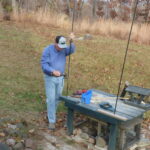
-
A few tools around the home help construct Fourth Floor Feeders
-
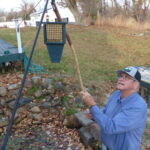
-
A pole with a hook makes lifting feeder high easy.
The birds love eating from the fourth story but there’s a problem. How to fill feeders so high up? Well, again, here’s how we solved the problem:
We scrounged a four-foot-long stick from a nearby lake that a beaver had cut and chewed off the bark. We bought an “S” hook from a hardware store and drilled a hole in the end of the stick. We pressed one side of the “S” hook into the wooden stick and had a handy tool.
With the hook on the stick, we can easily lift a feeder and hang it on the fourth story. A broomstick works as well as a beaver stick and the telescoping metal poles used to attach to paint rollers also can work. Most already have a hook built into the pole.
Squirrels can climb the steel shaft of the shepherd’s hook, but we foil them by coating its surface with a light spray of grease. Baffles are better at keeping these smart, pesky mammals at bay.
Materials Needed
Bird feeders
Picnic table
Shepherd’s Hook feeder holder
Pole for lifting feeder
“S” hookTube of spray grease
Helpful Tools
Drill and bit the same size as the shepherd’s hook’s diameter
Hammer
Although we still offer birdseed on the first, second, and third floors, now we present most of the seeds on the fourth floor. Saves seeds. Saves money. Frustrates deer, raccoons, turkeys, opossums, and squirrels.
-
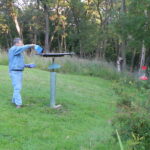
-
Hummingbird and platform feeders with baffle.
-
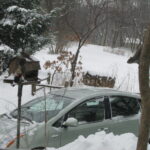
-
Squirrels quickly figure out how to access feeders
by Winding Pathways | Oct 27, 2022 | Birds, Nature
Hi all: Many people either don’t have feeders for birds or have reduced their giving of seeds due to higher expenses. Yet, we still like to note birds around. We encourage you to join Cornell University’s Project FeederWatch. From the website click on “About” on the tab and read more details of how you can enjoy watching and documenting birds starting November 1st.
-
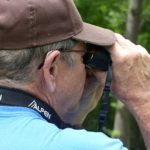
-
Bird watching is again a joy with hearing aids.
-
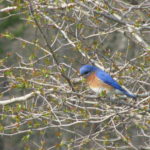
-
Bluebirds hang out on branches.
-
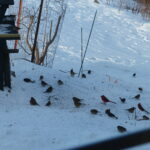
-
Birds flock to the seeds.
-
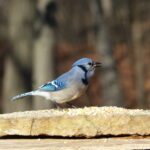
-
Usually jays come around only in winter.
-
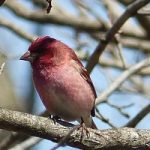
-
Some birds homestead at Winding Pathways.
-
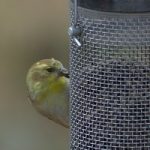
-
Songbirds appreciate high quality seed to sustain them in winter.
-
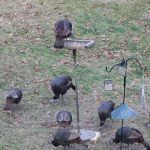
-
Turkeys and squirrels would make short work of seed, leaving none for the small birds.
-
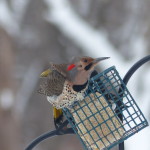
-
Winter is tough on birds so keep your feeders full.
-
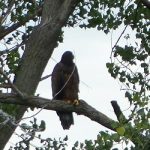
-
Fledgling eagle resting in the back yard.



































